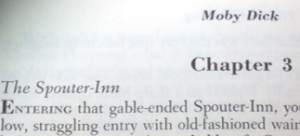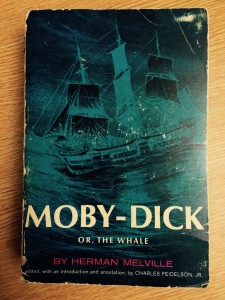
The third chapter of Moby Dick, “The Spouter-Inn,” is all about how to interpret new things. Ishmael, who settled on staying in the hotel called “The Spouter-Inn:–Peter Coffin,” tells readers about what he sees upon entering the hotel. Let us compare Ishmael to a medical student, first entering a new floor, say the neurology floor of a hospital. Ishmael and student are both faced with the task of making meaning from whatever presents itself. On that floor, the student wonders: who are the people sitting in the center of the floor? What is the meaning of the NPO signs next to some room entranceways? On entering Spouter-Inn, Ishmael wonders: what is this painting I see? What are the “monstrous clubs and spears” doing on the wall? I draw this comparison between Spouter-Inn and the neurology floor because I remember thinking about Ishmael’s first visit to that inn when I entered the neurology floor, where my physical diagnosis practice took place. I wasn’t sure what to expect, and there is not much to do for preparation. Like Ishmael, I just walked in and did my best to make sense of what I saw. If there was any “preparation” on my part, it was reading Moby Dick and knowing about the analogous situation of walking into a foreign Spouter-Inn.
For Ishmael, a painting hanging on the wall caught his attention, though he couldn’t make sense of what the painting was about. However descriptive he was about what he saw in the painting, he couldn’t give readers a definite sense of what the painting was. While you might see a painting at the Metropolitan Museum of Art and text your friend what you saw (Washington crossing the Delaware, or the like), Ishamel tells readers this:
A boggy, soggy, squitchy picture truly, enough to drive a nervous man distracted. Yet was there a sort of indefinite, half-attained, unimaginable sublimity about it that fairly froze you to it, till you involuntarily took an oath with yourself to find out what that marvellous painting meant. Ever and anon a bright, but, alas! deceptive idea would dart you through.–It’s the Black Sea in a midnight gale.–It’s the unnatural combat of the four primal elements.–It’s a blasted heath.–It’s a Hyperborean winter scene.–It’s the breaking-up of the ice-bound stream of Time…But stop; does it not bear a faint resemblance to a gigantic fish? even the great Leviathan himself?
Remembering Ishmael’s struggle to make sense out of that painting, I felt a comfort of familiarity, the best feeling I think that someone can feel when thrust in a new situation. It’s OK that Ishmael couldn’t make sense of the painting he saw on the wall, just as it’s OK that I didn’t know what to make sense of the labels telling me: NPO, or D5 0.45 NS. It’s no big deal to look those acronyms up on my smartphone, or just simply ask someone, the latter of what was done in Ishmael’s time: “based upon the aggregated opinions of many aged persons with whom I conversed upon the subject. The picture represents a Cape-Horner in a great hurricane.” This comfort of familiarity I mentioned earlier arises not necessarily from previously seeing the acronyms “NPO” and “D5 0.45 NS,” though seeing them before certainly does add to familiarity–no, this comfort comes from knowing that it’s not uncommon for someone, someone even as smart as Ishmael, to see something and be entirely uncertain what it is and to have several guesses as to its meaning.
Featured Image:
Silver Bank Outtakes by Christopher Michel







